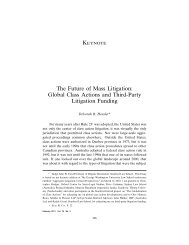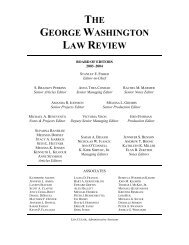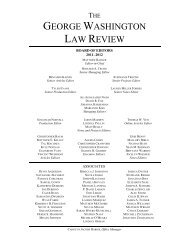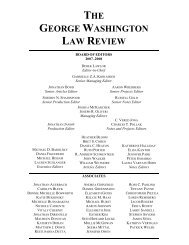View PDF - The George Washington Law Review
View PDF - The George Washington Law Review
View PDF - The George Washington Law Review
You also want an ePaper? Increase the reach of your titles
YUMPU automatically turns print PDFs into web optimized ePapers that Google loves.
2013] STOPS AND FRISKS, RACE, AND THE CONSTITUTION 7<br />
Moreover, the necessary discriminatory purpose implies more than “volition”<br />
or “awareness of consequences”—a state of mind often called “general<br />
intent.” 29 Instead, a challenger must prove that the decisionmaker acted<br />
with the “specific intent” to discriminate. A party challenging the application<br />
of a facially race-neutral policy must prove that the decisionmaker<br />
“selected or reaffirmed a particular course of action at least in part ‘because<br />
of,’ not merely ‘in spite of,’ its adverse effects upon an identifiable<br />
group.” 30<br />
What is quite damaging to the City’s case are three types of evidence<br />
that Judge Scheindlin described in detail: (1) NYPD commanders demanded<br />
that patrol officers satisfy an implicit quota of stops per month; 31 (2) the<br />
NYPD did not seriously review those stops to determine if they were valid;<br />
32 and (3) the NYPD may have relied on macro-level racial numbers<br />
(e.g., ninety percent of armed robberies in a particular neighborhood involve<br />
black offenders) as a basis for making micro-level stops and frisks<br />
(e.g., this black person is likely to be an armed robber). 33 That evidence<br />
impeaches the City’s defense that NYPD officers rely on specific and objective<br />
evidence of guilt, because it suggests that the City only cared about<br />
the number of stops, not the number of lawful stops. 34 As Judge Scheindlin<br />
put it, “[f]or the purposes of performance review, an unconstitutional stop<br />
is no less valuable to an officer’s career than a constitutional one—because<br />
the two are indistinguishable.” 35<br />
Judge Scheindlin found one piece of evidence particularly disturbing.<br />
At a meeting with former New York Governor David Patterson and a few<br />
senior state legislators, NYPD Commissioner Kelly said that “he focused<br />
on young blacks and Hispanics because he wanted to instill fear in them,<br />
every time they leave their home, they could be stopped by the police.” 36<br />
ington v. Davis, 426 U.S. 229, 242 (1976).<br />
29 Feeney, 442 U.S. at 279; see also United States v. Bailey, 444 U.S. 394, 403 (1980)<br />
(noting that the “venerable distinction” between general and specific intent has caused “a<br />
good deal of confusion”); WAYNE R. LAFAVE, CRIMINAL LAW § 5.2(e) (5th ed. 2010) (discussing<br />
the many different meanings of “general intent” in criminal law).<br />
30 Feeney, 442 U.S. at 279; see also, e.g., Armstrong, 517 U.S. at 463–67; McCleskey,<br />
481 U.S. at 292–93; Village of Arlington Heights, 429 U.S. at 266; <strong>Washington</strong>, 426 U.S. at<br />
242.<br />
31 See Floyd v. City of New York, No. 08 Civ. 1034 (SAS), 2013 WL 4046209, at<br />
*20–21, *26–33 (S.D.N.Y. Aug. 12, 2013).<br />
32 See id. at *24–25, *26–27, *33, *37–40, *42–47.<br />
33 See id. at *20–21.<br />
34 See id. at *33 (“In contrast to this detailed review for effectiveness, there is no process<br />
for evaluating whether enforcement activities are legally justified.”); id. at *37–40.<br />
35 Id. at *33.<br />
36 Id. at *36 (internal quotation marks omitted).









